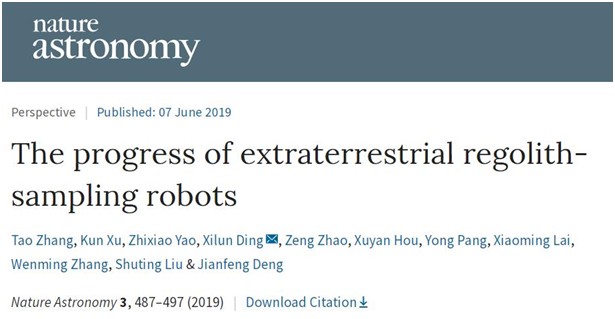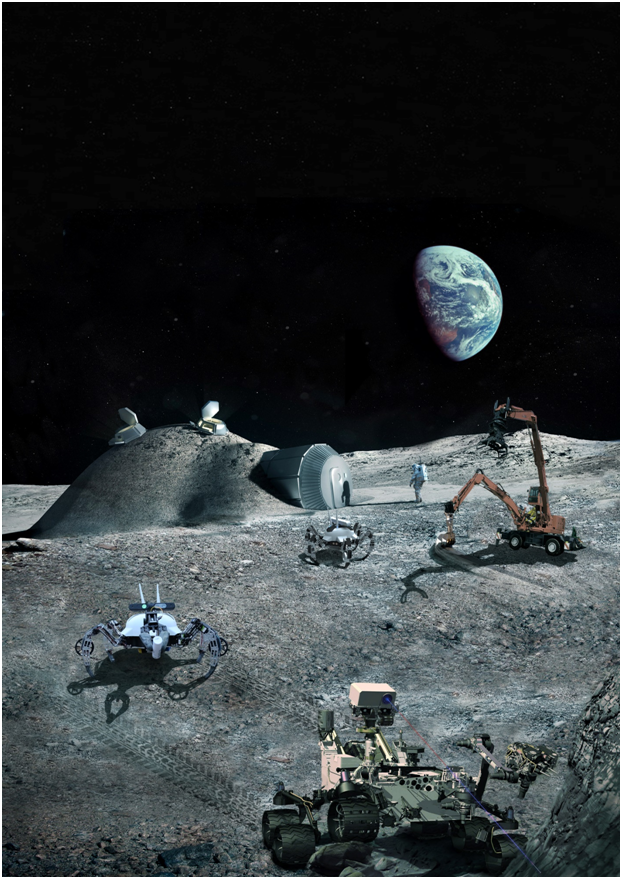Recently, the research team of Prof. Ding Xilun from the School of Mechanical Engineering and Automation published an article entitled “The Progress of Extraterrestrial Regolith-sampling Robots” in Nature Astronomy. Prof. Ding is the corresponding writer, and Dr. Zhang Tao, who received his doctoral degree from Beihang in 2017, is the first author of the article. Besides, Beihang is the first and the only corresponding institute of the research.

Prof. Ding Xilun from the School of Mechanical Engineering and Automation published a forward-looking article in Nature Astronomy
Regolith sample, the most effective and direct way to learn about a celestial body, is of great significance to explore the evidences of life or water in extraterrestrial celestial bodies and learn about the origin, development and evolution of the universe, which also offers a new approach for solving the problems of human survival and energy shortage. Being instrumental in acquiring regolith samples, extraterrestrial regolith-sampling robots play an important role in deep-spacing exploration. Unlike terrestrial robots, extraterrestrial robots usually work in harsh vacuum environment with drilling temperature and strong radiation. Besides, their weight, energy, size and material are subjected to certain restrictions like costs and launch capability.

An outlook on the extraterrestrial regolith-sampling robots
The article first offers an overview of the history and the development of extraterrestrial regolith-sampling robots, makes a contrast on the pros and cons and scope of application of different sampling methods, introduces the multi-rod deep driller for lunar subsurface sampling developed by the Beihang research team as well as the in-situ asteroid sampling and analysis robot made by the Beihang research team and other co-writers, and makes an in-depth discussion on the complicated restrictions and technical challenges of extraterrestrial sampling. According to the article, there are four problems, namely, multiple resource limits on earth, harsh extraterrestrial environment, uncertainty and diversity of extraterrestrial regolith and ultra-long-distance communication latency.
An in-depth analysis of the key ground-test technologies that guarantee the reliability and security of extraterrestrial sampling robotic systems is then presented. The tests include the normal test in an atmospheric environment, the endurance test in a vacuum low-temperature environment and the long-time autonomous sampling test. Next, a comprehensive perspective of the main technical trends in the development of new extraterrestrial regolith-sampling robots is given. Finally, a technical roadmap of China’s future space exploration missions is provided.
The research team led by Prof. Ding has been committed to the field of spatial mechanism and robot technology. They have made great contribution to the research of mechanical design, movement control and simulated analysis of extraterrestrial regolith-sampling robots as well as related simulation tests in extraterrestrial environment. Moreover, the team has developed many sampling drillers such as the multi-rod deep driller and six-wheel extraterrestrial exploration robot. This research is a key project (No. 51635002) as well as a general project (No. 51775011) of the National Natural Science Foundation of China.
The article is available at:
https://www.nature.com/articles/s41550-019-0804-1
Reported by Liang Yongjian
Reviewed by Chen Huawei
Edited by Jia Aiping
Translated by Xiong Ting

